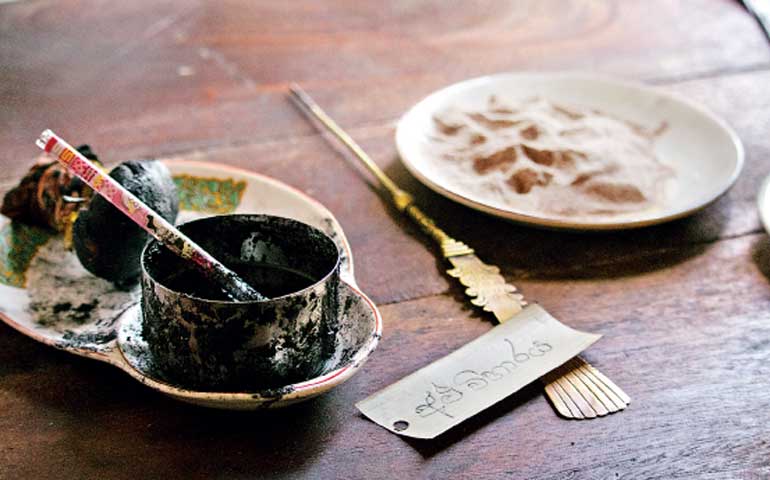Wednesday Nov 19, 2025
Wednesday Nov 19, 2025
Saturday, 25 November 2017 00:56 - - {{hitsCtrl.values.hits}}


By Aysha Maryam Cassim
The Pali Tripitakaya (Canon) can be attributed to Gautama Buddha and Theravada Buddhism. From the 5th century BCE to 1st century BCE, Buddha’s discourses and disciplines were passed on orally, memorised and recited by generations of monks to the next. Shortly after the demise of Lord Buddha, a council was held to collect and preserve his teachings in written form. According to scriptures, Alu Viharaya in Matale, Sri Lanka was the place where the Pitakas were first written.
Rewriting history
Tradition holds that these Tripitakayas were originally written by a conclave of monks who resided in the sacred cave shrines of Alu Viharaya. The epic reign of King Valagamba/Vattagamani (104-77 B.C.) was a politically turbulent century. It was during this time that caves became extremely popular among monks as meditation abodes.
When faced with the threat of South Indian invasions, King Valagamba fled his capital – Anuradhapura and sought refuge in the caves of Dambulla. Many monastery caves such as the ones found in Dambulla and Alu Viharaya, exhibit frescoes and Brahmi epigraphs revealing the existence of Buddhist erudition where Arahats among who were scribes and reciters completed the work of committing Buddhist text into writing.
The Matale Rebellion
In 1848, The Matale Rebellion led by Gongalegoda Banda and Veera Puran Appu took place in Ceylon against the British colonial government. During the Independence struggle which later ended up in a fierce battle, the image house along with some statues and some frescoes were vandalised and some original Buddhist manuscripts in the library were burnt by the defeated British Army in retaliation to the Sinhalese foot troops’ attacks.
In 1899, under the supervision and initiation of the late Chief Prelate of the Matale District and the Chief Abbot of Aluvihara, Venerable Tolambugolle Sri Sumangala Nayaka, the statues, frescoes and the buildings including the protective wall of the bo tree, were restored and reinforced.
The temple complex
The Alu Viharaya temple complex is perched on top of a rocky mound surrounding the serene hills of Mātale District.
Along the A9
Situated right on the main Kandy-Jaffna road (A9), about 4km from Matale town, Alu Viharaya is conveniently accessible to anyone coming along the Matale-Dambulla road. The pandal at the entrance is an arch constituted out of concrete. An ascent along the steep stone stairway will lead you to the frontage entrance where a mass of rocky boulders loom over the caves and palm trees. Then comes a spiral stone staircase that will take you to a sacred bo-tree with an image house. As you continue your way up the steps, the Chaithya at its summit gives a breath-taking view of the nearby Abhaya Mudra Golden Buddha Statue on the hills.
The wall paintings and at the Horror chamber depicts caricatures of various forms of torturous execution methods handed out by the devils to the sinners in the afterlife. In one of the chambers known as Balum Ge, a few of 32 capital punishments are shown in sculptures. The extremely gory and graphic display demonstrates the punishments inflicted on the criminals by the last King Sri Wicrama Rājasinghe.
The International Library and Museum
The International Library and Museum at Aluviharaya rock temple is a fascinating place for anyone with an interest in history. The foundation stone for this International Library and Museum was laid by His Royal Highness Crown Prince Sihanouk of Cambodia who had been in Sri Lanka to attend the Buddha Jayanthi Celebrations held in February 1957.
The library houses a repository of archaeological artifacts of cultural value related to Buddhist philosophy. There are antiques ranging from Buddha statues to marble and ceramic ware. There are gold plated Buddhist statues gifted by Myanmar, Thailand, Cambodia, China, and Japan. An array of well-bound Tripitakas written on Ola leaves in Pali are displayed on the bookshelves.
Ola leaf inscription – An art that still survives
Ola leaf writing had been a dominant writing material throughout South Asia dating back to the 5th century BC to 20th century A.D. Today when you visit The International Library and Museum at Aluviharaya, one can get a fascinating look into the art of inscribing on Ola leaves, demonstrating how the original and replacement Buddhist doctrines were documented in manuscripts using traditional technological process incorporated with cultural practices.
I met H.M.D Bandara, the Librarian of Alu Viharaya Temple, who gave me a fascinating demonstration of Ola Leaf inscription.
The tender leaves of the palmyra tree are processed into Ola leaves. Once the letters have been etched on the leaf with the aid of the Panhida (stile), the inking process known as ‘kalu madinawa’ begins.
A mixture of dummala oil, kakulu seed oil, and charcoal from the gaduma tree is used to produce the black dye. Then kurakkan flour is smothered on the paper to smoothen and fine-tune the lettering.
At the end of the tour in the museum, your name will be written on a piece of Ola leaf and given to you as a souvenir. A minor contribution to the guide is appreciated.